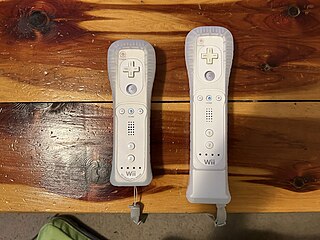
Virtual reality (VR) is a simulated experience that employs 3D near-eye displays and pose tracking to give the user an immersive feel of a virtual world. Applications of virtual reality include entertainment, education and business. VR is one of the key technologies in the reality-virtuality continuum. As such, it is different from other digital visualization solutions, such as augmented virtuality and augmented reality.

360-degree videos, also known as surround video, or immersive videos or spherical videos, are video recordings where a view in every direction is recorded at the same time, shot using an omnidirectional camera or a collection of cameras. The term 360x180 can be used to indicate 360° of azimuth and 180° from nadir to zenith. During playback on normal flat display the viewer has control of the viewing direction like a panorama. It can also be played on a display or projectors arranged in a sphere or some part of a sphere.

In computing, a motion controller is a type of input device that uses accelerometers, gyroscopes, cameras, or other sensors to track motion.

Oculus Rift is a discontinued line of virtual reality headsets developed and manufactured by Oculus VR, a virtual reality company founded by Palmer Luckey that is widely credited with reviving the virtual reality industry. It was the first virtual reality headset to provide a realistic experience at an accessible price, utilizing novel technology to increase quality and reduce cost by orders of magnitude compared to earlier systems. The first headset in the line was the Oculus Rift DK1, released on March 28, 2013. The last was the Oculus Rift S, discontinued in April 2021.

Reality Labs, formerly Oculus VR, is a business and research unit of Meta Platforms that produces virtual reality (VR) and augmented reality (AR) hardware and software, including virtual reality headsets such as Quest, and online platforms such as Horizon Worlds. In June 2022, several artificial intelligence (AI) initiatives that were previously a part of Meta AI were transitioned to Reality Labs. This also includes Meta's fundamental AI Research laboratory FAIR which is now part of the Reality Labs - Research (RLR) division.

The Samsung Gear VR is a virtual reality headset developed by Samsung Electronics, in collaboration with Oculus VR, and manufactured by Samsung. The headset was released on August 21, 2015.

HTC Vive is a line of virtual and mixed reality headsets produced by HTC Corporation. The brand currently encompasses headsets designed for use with personal computers as well as standalone headsets such as the Vive Focus line, Vive Flow glasses, and the Vive Elite XR mixed reality headset.

A virtual reality headset is a head-mounted device that uses 3D near-eye displays and positional tracking to provide a virtual reality environment for the user. VR headsets are widely used with VR video games, but they are also used in other applications, including simulators and trainers. VR headsets typically include a stereoscopic display, stereo sound, and sensors like accelerometers and gyroscopes for tracking the pose of the user's head to match the orientation of the virtual camera with the user's eye positions in the real world.
Virtual Desktop is remote control software for Android-based virtual reality headsets. It allows users to control a PC over a wireless LAN from the headset, including the ability to stream VR games and software.
Tilt Brush is a room-scale 3D-painting virtual-reality application available from Google, originally developed by Skillman & Hackett.

Batman: Arkham VR is a virtual reality adventure video game developed by Rocksteady Studios and published by Warner Bros. Interactive Entertainment for PlayStation 4 and Windows. Based on the DC Comics superhero Batman, it is part of the Batman: Arkham series and the first installment to use virtual reality headsets, allowing players to experience the game world from Batman's perspective. Arkham VR was released worldwide on October 11, 2016, for PlayStation 4 and on April 25, 2017, for Windows for VR headsets.
Radial-G: Racing Revolved is an indie racing game, which was developed by Tammeka Games and was released on March 28, 2016, for the Oculus Rift. HTC Vive and Razer OSVR support via the Steam version was released April 5, 2016 and is going to be released on Sony PlayStation VR on September 12, 2017 for EU regions with U.S. dates to be announced.
Lamber Goodnow Injury Lawyers is a legal team known for their work on implementing virtual reality (VR) technology for use in court cases in the United States.

A virtual reality game or VR game is a video game played on virtual reality (VR) hardware. Most VR games are based on player immersion, typically through a head-mounted display unit or headset with stereoscopic displays and one or more controllers.

Oculus Rift CV1, also known simply as Oculus Rift, is a virtual reality headset developed by Oculus VR, a subsidiary of Meta Platforms, known at the time as Facebook Inc. It was announced in January 2016, and released in March the same year. The device constituted the first commercial release in the Oculus Rift lineup.

SexLikeReal (SLR) is a virtual reality pornography sharing site, VR live cam streaming, production company and VR technology developer. It was launched in 2015 with the top Studios such as VR Bangers, VR Conk, BadoinkVR, Virtualrealporn and more than one of the largest Netflix-like platforms for VR pornography, SexLikeReal has been featured by XBIZ and other major media outlets in the adult entertainment industry. According to Venture Beat, SexLikeReal is pioneering in merging adult entertainment with VR technology.
Mehzeb Rahman Chowdhury is a Bangladeshi author, inventor, instructor, journalist, criminologist, criminal law barrister, social sciences researcher and filmmaker. His journalism works are featured in various international publications such as the Daily Mail, The Independent, The Conversation, Forensic Magazine, Sci-Fi Generation, Space.com, and Netzpiloten Magazin. He is also known for his invention of the MABMAT Crime Scene Imaging Rover.
YouTube VR is a software application which offers an interface for YouTube made for VR headsets.











